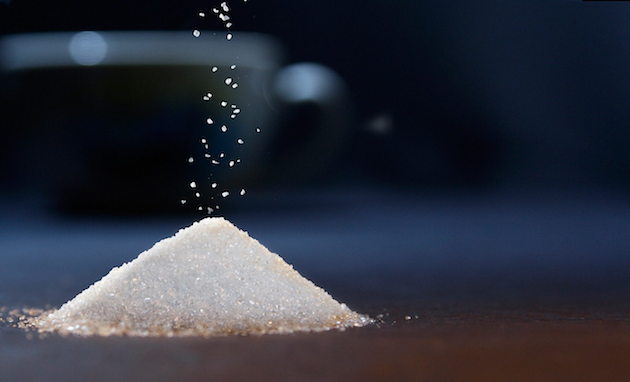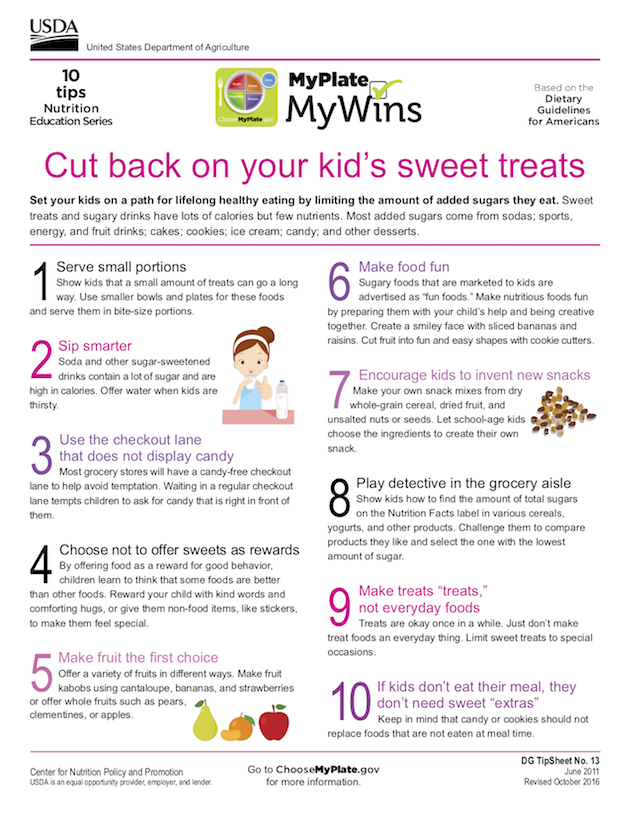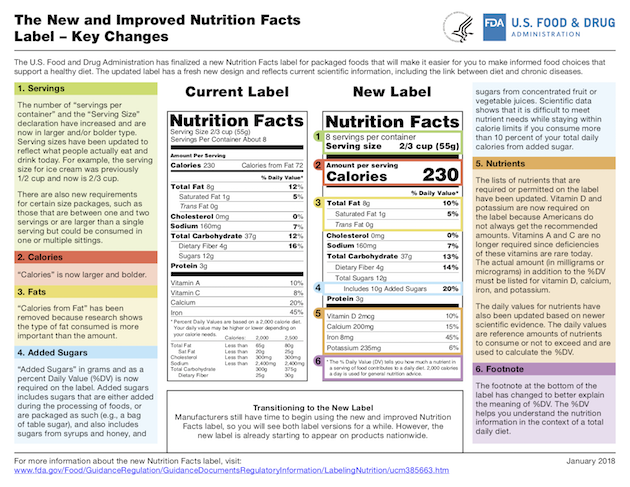Some people crave bacon or steak or even fried foods. I crave sugar, and the apple has not fallen far from the tree. My son, in particular, has a sweet tooth, and despite my push for fruit over popsicles and milk over juice, it has been a struggle to reduce sugar intake in our household. I am a label reader, and I avoid processed foods with added sugars when possible. But our family could stand to do better and we are not alone. According to the National Health and Nutrition Examination Survey, children in the US are consuming, on average, 350 calories per day from added sugars. This is 3 1/2 times the amount recommended by the American Heart Association. According Jessica Brown, a clinical dietitian at CHOC Children’s, most families are consuming too much sugar. But fortunately, with some easy tips families can reduce sugar intake and curb cravings over time.

Common Sources of Sugar
As expected, the most common (and obvious) sources of sugar include soda, fruit drinks, sports drinks, energy drinks, flavored yogurt, breakfast cereal, candy, and cookies. According to Brown, less obvious sources of sugar can include salad dressings, BBQ sauces, ketchup and other condiments, dried and canned fruit, pasta sauce, granola bars, and instant oatmeal. According to the CDC, over 60% of children will drink a sugar-sweetened beverage on any given day and this is the source of added sugar in a majority of children.

The Daily Recommendation for Sugar Intake in Children
According to the American Heart Association, children should consume less than 25 grams of added sugar per day. This is the equivalent of 100 calories coming from added sugar, or 6 teaspoons per day. Children under the age of 2 should not have any food or beverages with added sugars. One can of soda exceeds this recommended amount at nearly 40 grams, and one juice box can contain as much as 25 grams of sugar per serving.
Despite how easy it is to go over the American Heart Association’s recommendation, Brown stressed that it is more important for parents to pay attention to portion sizes rather than restricting foods. Modify the portion sizes to limit the amount of sugar being consumed.

The Physical Effects of Sugar
The physical effects of overconsumption of sugar are well-documented and include obesity, diabetes, cardiovascular disease, and dental cavities. Sugar is rapidly absorbed into the blood stream and causes rapid spikes in blood sugar with resultant highs and lows. According to Brown, some research also demonstrates that sugar can be a form of addiction with children craving or constantly thinking about sugary foods.
According to Brown, medical literature has been inconclusive with regards to the association between sugar intake and hyperactivity. Some may argue that the environment where sugar-rich foods are consumed (i.e. birthday parties) can result in an increase in hyperactivity among children.

The Truth About Added Sugars
According to Brown, at the end of the day sugar is sugar, irrespective of its form. However, naturally occurring sugars, like those found in fruit and dairy products, also contain additional nutrients such as fiber, potassium, Vitamin C, and Calcium. Added sugars are added in during the processing or preparation of foods and do not enhance the nutritional value of those foods (only the flavor). The result is typically an overconsumption of those foods and resultant excess caloric intake.
Perhaps one of the most impactful changes families can make is to modify their intake of sugary beverages. According to the American Academy of Pediatrics, children should only consume 4-6 ounces of juice per day. The recommendation for toddlers is less at 4 ounces per day. Opt for sparkling water with natural flavors or citrus as a way to reduce sugar intake associated with juice consumption.

How to Reduce Sugar Intake
Reducing sugar intake begins at the grocery store. If it is not purchased, it is not in the house and less likely that families will consume it. Brown recommends that parents become skilled at reading labels to scan products for added sugar. Look at the ingredients and scan for varied forms of sugar including agave, brown sugar, fructose, high fructose corn syrup, honey, brown rice syrup, molasses, and raw sugar.
- Opt for naturally-sweetened foods. Examples include snack bars sweetened with dates, unsweetened applesauce, and no-sugar-added nut butters.
- Modify breakfast. Most sugar consumption begins at the breakfast table with muffins, sugar-rich cereals, pancakes, and flavored yogurt. Brown recommends making an impact at the beginning of the day by choosing savory dishes like eggs and avocado toast. Banana slices can be used to sweeten dishes like oatmeal or unsweetened cereals in place of added sugars. Fruit and vegetable smoothies sweetened with dates can replace store-bought smoothies and juices. Lastly, opt for unsweetened foods like yogurt and add fruit or natural sweeteners like honey to gain more control over the amount of sugar being added to foods.
- Look for breads and other foods sweetened with honey or brown rice syrup instead of high fructose corn syrup
- Choose fruit as a dessert
- Limit processed foods (which will thereby limit added sugar intake)
- Opt for naturally occurring sugars in fruit and dairy products
- While it is ok for families to consume sweets, strive to limit portion sizes and frequency

Choose My Plate offers families a valuable resource for cutting back on sweet treats. Brown recommends that families print out these tips and place them on the refrigerator in order to try to tackle one per week.

Additionally, a new nutrition facts label is being introduced to make it easier for families to identify added sugars. While some manufacturers have made these changes, every food manufacturer must comply by 2020. The new label will include added sugars so that families can identify which sugars are naturally occurring and how much sugar was added to foods during processing. The result is that families will be able to more readily identify hidden sugars in foods.
CHOC Children’s Nutritional Initiatives
CHOC Children’s recently launched a new inpatient menu offering healthier food choices. The result is a menu with limited amounts of processed foods and the addition of more whole grains, fruits, and vegetables. The facility has removed ice cream, chocolate syrup, and cookies from their smoothies and shakes. Their new inpatient smoothie menu is a great model for families and now replaces previous sugar-rich desserts. Each smoothie includes vegetables and is made with full-fat Greek yogurt. Spinach, chia seeds, and other nutrient-rich ingredients have been added to give patients the nutritional boost they need while in the hospital.
The Charlie Cart Project was also launched to teach families how to cook healthy foods. This mobile kitchen cart can be taken throughout the facility to teach patients, families, and even employees culinary medicine. You can learn more about the Charlie Cart Project by visiting their website.

Jessica Brown, Pediatric Clinical Dietitian at CHOC Children’s Hospital
Jessica Brown received her BS in Nutritional Sciences at Cornell University in Ithaca, NY, and completed her Dietetic Internship at Miami Valley Hospital in Dayton, OH. Jessica is a Board Certified Specialist in Pediatric Nutrition (CSP), a Certified Nutrition Support Clinician (CNSC), and a Certified Lactation Educator Counselor (CLEC). She has worked as a Pediatric Clinical Dietitian at CHOC Children’s Hospital since 2007. She currently works with CHOC Children’s Feeding Program as well as the Neuroscience Institute managing ketogenic diets for children with epilepsy. Jessica has been involved in several research initiatives including first author publication describing short-term outcomes of children with pediatric feeding disorders treated in an intensive inpatient multidisciplinary program. She is actively working on long-term outcomes of an intensive inpatient feeding program, the effects of blenderized diets on feeding tolerance and oral intake, as well as nutrient intake among children with feeding disorders. She is also a co-investigator for a study exploring the ketogenic diet as a complementary metabolic therapy in pediatric recurrent/refractory solid tumors. Jessica serves on the American Society for Parenteral and Enteral Nutrition Weaning Committee developing a consensus statement on pediatric gastrostomy tube weaning. She has been published in the areas of ketogenic diet therapy, feeding disorders and blenderized tube feedings as well as a national and regional speaker.
- Discover Luxury at Sonesta Irvine: Your Ideal Staycation - August 8, 2024
- CHOC Walk Returns to the Disneyland Resort – Special Events and Ways to Support - June 28, 2023
- Beastly Ball Returns to the Los Angeles Zoo - May 8, 2023


Leave a Reply